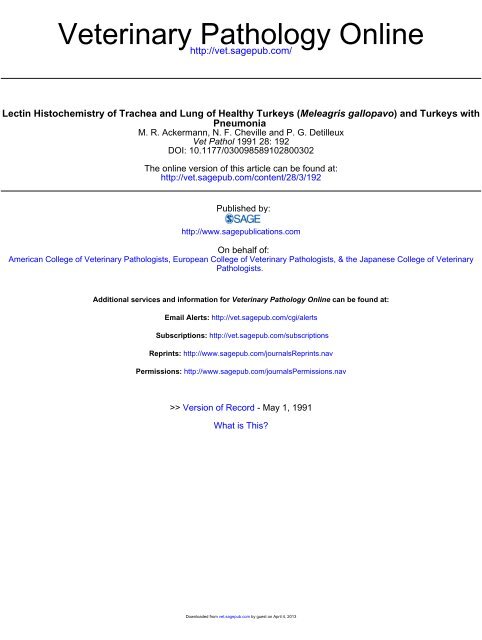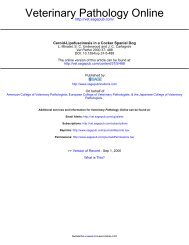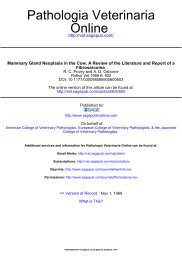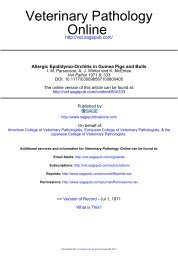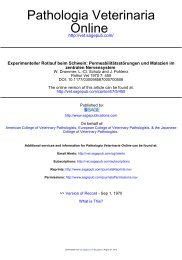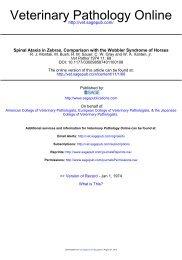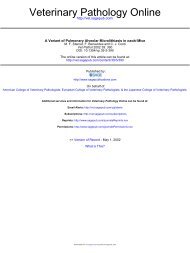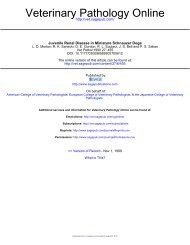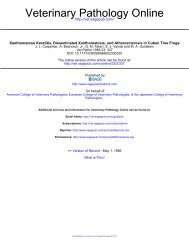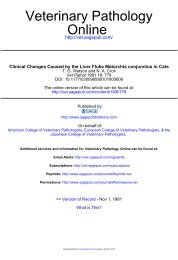Lectin Histochemistry of Trachea and Lung of Healthy Turkeys ...
Lectin Histochemistry of Trachea and Lung of Healthy Turkeys ...
Lectin Histochemistry of Trachea and Lung of Healthy Turkeys ...
Create successful ePaper yourself
Turn your PDF publications into a flip-book with our unique Google optimized e-Paper software.
Veterinary Pathology Online<br />
http://vet.sagepub.com/<br />
<strong>Lectin</strong> <strong>Histochemistry</strong> <strong>of</strong> <strong>Trachea</strong> <strong>and</strong> <strong>Lung</strong> <strong>of</strong> <strong>Healthy</strong> <strong>Turkeys</strong> ( Meleagris gallopavo)<br />
<strong>and</strong> <strong>Turkeys</strong> with<br />
Pneumonia<br />
M. R. Ackermann, N. F. Cheville <strong>and</strong> P. G. Detilleux<br />
Vet Pathol 1991 28: 192<br />
DOI: 10.1177/030098589102800302<br />
The online version <strong>of</strong> this article can be found at:<br />
http://vet.sagepub.com/content/28/3/192<br />
Published by:<br />
http://www.sagepublications.com<br />
On behalf <strong>of</strong>:<br />
American College <strong>of</strong> Veterinary Pathologists, European College <strong>of</strong> Veterinary Pathologists, & the Japanese College <strong>of</strong> Veterinary<br />
Pathologists.<br />
Additional services <strong>and</strong> information for Veterinary Pathology Online can be found at:<br />
Email Alerts: http://vet.sagepub.com/cgi/alerts<br />
Subscriptions: http://vet.sagepub.com/subscriptions<br />
Reprints: http://www.sagepub.com/journalsReprints.nav<br />
Permissions: http://www.sagepub.com/journalsPermissions.nav<br />
>> Version <strong>of</strong> Record - May 1, 1991<br />
What is This?<br />
Downloaded from<br />
vet.sagepub.com by guest on April 4, 2013
Vet Pathol 28:192-1 99 (199 1)<br />
<strong>Lectin</strong> <strong>Histochemistry</strong> <strong>of</strong> <strong>Trachea</strong> <strong>and</strong> <strong>Lung</strong> <strong>of</strong> <strong>Healthy</strong> <strong>Turkeys</strong><br />
(Meleagris gallopavo) <strong>and</strong> <strong>Turkeys</strong> with Pneumonia<br />
M. R. A CKERMANN, N. F. CHEVILLE, AND P. G. D ET ILLEUX<br />
US Department <strong>of</strong> Agriculture, Agricultural Research Service,<br />
National Animal Disease Center, Ames, IA<br />
Abstract. Thirteen lectins were used to characterize lectin-binding specificity <strong>of</strong> glycoconjugates on sections<br />
<strong>of</strong> formalin-fixed lung <strong>and</strong> trachea from seven normal turkeys, two turkeys with acute pneumonia, <strong>and</strong> two<br />
turkeys with chronic pneumonia. Neuraminidase was used to digest sialic acid residues. One N-acetylgalactosarnine-binding<br />
lectin <strong>and</strong> two N-acetylgalactosamine/galactose-binding lectins stained the apical membrane<br />
<strong>and</strong> cytoplasm <strong>of</strong> multi focal cells that lined air atria <strong>and</strong> hyperplastic granular cells. Other lectins in these groups<br />
stained ciliated cells <strong>of</strong> the trachea <strong>and</strong> bronchi <strong>and</strong> air capillary epithelial cells. Sialic acid residues were on<br />
apical surfaces <strong>of</strong> ciliated <strong>and</strong> nonciliated tracheal <strong>and</strong> bronchial lining cells, air capillary epithelial cells, <strong>and</strong><br />
vascular endothelial cells. Mannose/glucose-bind ing lectins stained reticular <strong>and</strong> elastic fibers in the lamina<br />
propria <strong>of</strong> trachea, primary <strong>and</strong> secondary bronchi , <strong>and</strong> the tunica adventitia <strong>of</strong> arteries <strong>and</strong> veins. By transmission<br />
electron microscopy, colloidal gold-Arachis hypogaea (peanut agglutinin) labeled microvilli on the apical<br />
surface <strong>of</strong> mature granular cells. The L-fucose-bindin g lectin, in addition to several other lectins, stained<br />
nonspecifically in both trachea <strong>and</strong> lung. These studies show that granular cells that line air atria can be identified<br />
with lectins <strong>of</strong> N-acetylglucosamine <strong>and</strong> N-acetylgalactosamine/galactose groups, <strong>and</strong> that apical surfaces <strong>of</strong><br />
epithelial cells <strong>and</strong> endothelial cells in the trachea <strong>and</strong> lung express terminal sialic acid residues.<br />
Key words: Avian species; granular cells; lectins; peanut agglutinin; type II pneumocytes.<br />
Gl ycoconjugates comprising th e glycocalyx <strong>of</strong> the<br />
respiratory epithelium are essential to normal mucociliary<br />
<strong>and</strong> respiratory function. Sugar residues <strong>of</strong>glycoconjugates<br />
can also serve as receptor sites for respiratory<br />
pathogens.v'? Experimentally, fimbrial-mediated<br />
attachment <strong>of</strong>Escherichia coli. a respiratory pathogen<br />
<strong>of</strong> poultry, to th e tracheal mucosa <strong>of</strong> chickens can be<br />
blocked by D -mannose residues . 10 In turkeys, fimbriamediated<br />
adherence <strong>of</strong> E. coli to the respiratory tract<br />
epithelium has not been demonstrated.i-><br />
for type I (D-mannose-binding) fimbriae <strong>of</strong>E. coli, 2)<br />
characterize lectin-binding affinities to specific cell<br />
types, <strong>and</strong> 3) identify sialic acid residues. A panel <strong>of</strong><br />
lectins was used to stain trachea <strong>and</strong> lung from healthy<br />
3-week-old turkeys, IS-day-old turkeys with acute<br />
pneumonia, <strong>and</strong> IO-week-old turkeys with chronic<br />
pneumonia an d granular cell hyperplasia. Sialic acid<br />
residues were identified using neuramini dase enzyme<br />
digestion.<br />
Biochemical characterization <strong>of</strong> epithelial cell gly- Materials <strong>and</strong> Metho ds<br />
coconjugates is generally difficult, since samples are Distal trachea <strong>and</strong> lung sections from seven (Nos. 1-7),<br />
<strong>of</strong>t en contaminated with sloughed cells, bacteria, <strong>and</strong> Broad-Breasted White, 3-week-old turkeys were fixed in<br />
rnucus.P Biotinylated lectins ha ve been used histo- 10% neutral buffered formalin <strong>and</strong> stained with hematoxylin<br />
ch emically, therefore, to determine binding affinities <strong>and</strong> eosin, Verhoeff-van Gieson stain, Gomori's reticulum<br />
to respiratory epithelial cells lining the trachea or lung stain, Masson's Trichrome stain, <strong>and</strong> 13 different biotinyl<strong>of</strong><br />
the rat, mouse, hamster, human fetus, <strong>and</strong> the hu- ated lectins (Vector Laboratories, Burlingame, CA) using a<br />
man adult.4,5,7, 15, 18.2 1,22,27 Studies <strong>of</strong> human fetal lung direct peroxidase technique (Table I). Briefly, serial (3 jlm)<br />
ha ve demonstrated sialidation <strong>of</strong> alveolar lining cells sections were deparaffinized with xylene. Endogenous perduring<br />
maturation. Normal <strong>and</strong> hyperplastic type II oxidase was quenched with absolute methanol containing<br />
pn eumocytes isolated from lungs <strong>of</strong> adult human be- 0.6% H20 2 <strong>and</strong> 0.074% HC!. Sections were rinsed with distilled<br />
water, a Tris solution containing 0.1 mM Ca' ' <strong>and</strong><br />
ings can be identified with a lectin, M ac/ura pomiferia Mg++, then I% bovine serum album in in the Tris solution,<br />
agglutinin, which bi nds a type II cell-specific glyco- followed by a I-hour incubation with a lectin-Tris solution.<br />
protein. v" Granular cells <strong>of</strong>turkeys that are capable <strong>of</strong> Diamin obenzoic acid was used as a chromogen, <strong>and</strong> sections<br />
hyperplasia <strong>and</strong> secrete surfactant may be analogous were counterstained with Harris' hematoxylin . The lowest<br />
to typ e II cells <strong>of</strong> mammals.t--" concentration <strong>of</strong> each lectin that resulted in specific, defini-<br />
This study was designed to I) identify adhesion sites tive staining was used for both trachea <strong>and</strong> lung sections.<br />
192<br />
Downloaded from<br />
vet.sagepub.com by guest on April 4, 2013
Table 1. The concentrations <strong>of</strong> the lectins used in thi s<br />
study (Golstein <strong>and</strong> Peretz)."<br />
<strong>Lectin</strong><br />
Glu cose/mannose group<br />
Conavalia ensiformis<br />
(Jack bean)<br />
Lens culinaris<br />
Pisum sativum<br />
N-acetylglucosamine<br />
group<br />
Triticum vulgare<br />
(Wheat germ )<br />
Su ccinylat ed Triticum<br />
vulgare<br />
N-acetylga lactosaminel<br />
galactose group<br />
Glycin maximus<br />
(Soyb ean agglutinin)<br />
Sophora japonicum<br />
Arachis hypogaea<br />
(Peanut agglut inin)<br />
Phaesolus vulgaris<br />
(leukoagglutinin)<br />
Ricinus com m unis J<br />
Griffonia simplicifolia J<br />
Phaesolus vulgaris<br />
(erythroagglutinin)<br />
L-fucose gro up<br />
Ulex europeas I<br />
Abbreviation<br />
* Concentration used on tissue sections from IO-week-old poults.<br />
<strong>Lectin</strong> <strong>Histochemistry</strong> <strong>of</strong> Turkey <strong>Lung</strong> 193<br />
Con A 5.0<br />
LCA 2.5<br />
PEA 2.5<br />
WGA 2.5<br />
sWGA 2.5<br />
SBA 2.5<br />
<strong>Lectin</strong> Con-<br />
centration<br />
(ug/rnl)<br />
SJA 5.0<br />
PNA 2.5 ; 5.0*<br />
PHA-L 2.5<br />
RCA -I 1.25<br />
BSL-I 50.0<br />
PHA-E 50.0<br />
U EA-I 50.0<br />
<strong>Lectin</strong>-binding specificity was tested by mixing each lectin<br />
with a 0.1 M solution <strong>of</strong> its inhibitory sugar for 20 minutes<br />
before application, or by treating sect ions with I% sodium<br />
periodate, for 10 m inutes, prior to labeling; both techniques<br />
prevented staining. Several sections were incubated with Vibrio<br />
cholera neuraminidase (NA , I U/ml [Sigma, St. Louis,<br />
MOD for 18 hours at 37 C <strong>and</strong> then stained with Arachis<br />
hypogaea (PNA) or Triti cum vulgare (WGA) for the detection<br />
<strong>of</strong> sialic acid residues. Several sect ions were incubated with<br />
galacto se oxidase (5 U/m !) for 18 hours at 25 C <strong>and</strong> stained<br />
with PNA. Galactose oxidase oxidizes galacto se residues into<br />
aldehyde s that are not bound by PN A.<br />
To determine ifacut e inflammation altered lectin affinities,<br />
the battery <strong>of</strong> lectins was also used on similarly prepared<br />
sections <strong>of</strong> trachea <strong>and</strong> lung from two (Nos. 8, 9) 3-weekold<br />
Broad-Breasted White turkeys experimentally ino culated<br />
intratracheally with E. coli 0143:K*:H27. The battery <strong>of</strong><br />
lectins was also used on trachea <strong>and</strong> lung sections <strong>of</strong> two<br />
(Nos. 10, II) 10-week-old Broad -Breasted White turkeys with<br />
chronic pneumonia, caused by experimenta l infection with<br />
Chlamydia psittaci, to determine ifhyperplasti c granular cells<br />
sta ined simi larly to non -hyperplastic granular cells. Normal<br />
areas <strong>of</strong>lung from turkeys with acute <strong>and</strong> chronic pneumonia<br />
serve d as internal controls to compare staining patterns to<br />
3-week-old hea lthy poults (Nos. 1-7).<br />
Arachis hypogaea (PNA) conjugated with 15-nm colloidal<br />
gold (Po lysciences, Inc. , Warrington, PA) was directly labeled<br />
to lung tissue for transmission electron microscopy. <strong>Lung</strong><br />
sam ples 0.5 x 0.5 cm from four , 3-week-old, Broad-Breasted<br />
White turkeys were fixed in 2.5% glutaraldehyde (pH 7.4)<br />
for 4 hours <strong>and</strong> stored in 0.1 M cacodylate buffer (pH 7.4).<br />
T he sam ples were rinsed in microtiter plate wells containing<br />
0.2 M phosphate buffered saline with 1.0% bovine serum<br />
albumin for 5 minutes <strong>and</strong> transferred to a solution <strong>of</strong>goldlabeled<br />
PNA (34 fig/ml) for I hour, then washed three times<br />
for 5 minutes with bovine serum albumin. Control tissues<br />
were either processed without lectin or incubated with the<br />
gold -lectin previous ly mixed with either 0.1 M N-acetylgalactosamine<br />
or 0.1 M D-galactose. Tissues were post -fixed<br />
in 1% osmium tetroxide (pH 7.4), embedded in EPON, <strong>and</strong><br />
thin sections were stained with lead citrate <strong>and</strong> uranyl acetate.<br />
Thin sections were examined on a Philips electron microscop<br />
e (Mahwah, NJ) .<br />
Results<br />
Each lectin-binding group (mannose-glucose , N-acetylglucosamine,<br />
N-acetylgalactosamine/galactose, <strong>and</strong><br />
L-fucose) stained different areas <strong>of</strong> tissue , but most<br />
lectins within a group stained similarly (Tables 2, 3).<br />
No staining was present in lung or trachea when the<br />
Table 2. <strong>Lectin</strong> histochemical staining <strong>of</strong>components <strong>of</strong> distal tracheas from seven, healthy, 3-week -old turkeys (Nos.<br />
1-7).<br />
D-mannose<br />
Groups*<br />
nAcGlc nAcGal NA<br />
Con A LCA PEA WGA PHA-L RCA-I PNA NA/PNA<br />
Lamina propria 7/7t 7/7 7/7 0:1: 0 2/7 0 0<br />
Adventitia <strong>of</strong> blood vesse ls 7/7 7/7 7/7 0 0 0 0 0<br />
Ciliated cells 0 0 0 5/7 0 0 0 7/7<br />
Nonciliated cells 0 0 0 0 4/7 5/7 0 7/7<br />
* Group abbreviations indicate: D-mannose group; nAcGlc = N-acetylglucosamine group; nAcGal = N-acetylgalactosamine group;<br />
NA = neuraminidase (NA) treatment followed by staining with Arachis hypogaea (PNA).<br />
t Indicates number <strong>of</strong> poults with specific staining/number tested.<br />
:j: 0 = no specificstaining.<br />
Downloaded from<br />
vet.sagepub.com by guest on April 4, 2013
194 Ackermann, Cheville, <strong>and</strong> Detilleux<br />
Table 3. Lect in histochemical sta ining <strong>of</strong> co m po nents <strong>of</strong> lun gs from seven, healthy, 3-week-o ld turkeys.<br />
Groups"<br />
D-mannose nAcGIc nAcGal NA<br />
Con A LCA PEA WGA sWGA SBA PNA PHA-L RCA-I NN PNA<br />
Lami na propria <strong>of</strong> bronchi 7/7t 7/7 7/7 0:1: 0 0 0 0 0 0<br />
Adventi tia <strong>of</strong> blood vessels 7/7 7/7 7/7 0 0 0 0 0 0 0<br />
Ciliated bronch ial cells§ 0 0 0 6/7 0 0 0 2/7 1/7 7/7<br />
Nonciliated bronchial cells§ 0 0 0 5/7 0 0 0 5/7 4/7 7/7<br />
Air ca pillary epithelial cells 0 0 0 7/7 0 0 0 0 5/7 7/7<br />
Air atria lining cells 0 0 0 7/7 7/7 7/7 7/7 7/7 7/7 7/7<br />
Endo the lial cells 0 0 0 5/7 0 0 0 0 0 7/7<br />
* Group abbreviation indicate: D-mannose group; nAcGIc = N-acetylglucosamine group; nAcGal = N-acetylgalactosamine group;<br />
NA = neuramin idase (NA) treatment followed by staining with Arachis hypogaea (PNA).<br />
t Indicates number <strong>of</strong> poults with specific staining/number <strong>of</strong> poults tested.<br />
t 0 = no specific staining.<br />
§ Primary <strong>and</strong> secondary bronchi only.<br />
appropriate blocking sugar was preincubated with lectin<br />
or in periodate-treated sections.<br />
In healthy turkeys, the mannose/glucose-binding<br />
lectins , Conavalia ensiformis (Con A), Lens culinaris<br />
(LCA), <strong>and</strong> Pisum sativum (PEA) consistently (7/7 turkeys)<br />
stained the lamina propria <strong>of</strong> the trachea <strong>and</strong><br />
pulmonary bronchi <strong>and</strong> the ad ventitia <strong>of</strong>lung <strong>and</strong> trachea<br />
blood vessels (Fig. I). Th ese lectins also stained<br />
small vacuoles in epithelial cells that lined trachea, but<br />
failed to stain the apical membrane. Triticum vulgare<br />
(WGA) inconsistently stained the apical membranes<br />
<strong>of</strong> ciliated cells <strong>of</strong> the trachea (5/7 ), primary <strong>and</strong> secondary<br />
bronchi (6/7), <strong>and</strong> capillary endothelial cells<br />
(5/7), <strong>and</strong> consistently stained cells that lined air atria<br />
<strong>and</strong> air capillary epithelial cells. In contrast, succinylated<br />
Triticum vulgare (sWGA) stained only the apical<br />
cytoplasm <strong>and</strong> surface <strong>of</strong> cells that line air atria <strong>and</strong><br />
did not stain tracheal cells.<br />
Glycin maximus (SBA), Arachis hypogaea (PNA) ,<br />
Phaesolus vulgaris (PHA-L), <strong>and</strong> R icinus communis I<br />
(RCA-I) stained the apical surface <strong>of</strong>cells that line air<br />
atri a; in addition, PHA-L <strong>and</strong> RCA-I inconsistently<br />
stained oth er cell types, i.e., PHA-L stained apical surfaces<br />
<strong>of</strong> nonciliated cells <strong>of</strong> the trachea, <strong>and</strong> ciliated<br />
<strong>and</strong> nonciliated cells <strong>of</strong> the primary <strong>and</strong> secondary<br />
bronchi, while RCA-I stained apical surfaces <strong>of</strong> nonciliated<br />
cells <strong>of</strong> the trachea, primary <strong>and</strong> secondary<br />
bronchi, <strong>and</strong> air capilla ry epithelial cells. Staining <strong>of</strong><br />
air atria lining cells by both N-acetylglucosamin e (WGA<br />
<strong>and</strong> sWGA) <strong>and</strong> N-acetylgalactosamine/galactose<br />
(SBA, PNA, PHA-L, <strong>and</strong> RCA-I)-binding lectins was<br />
discontinuous, i.e., multifocal, individual cells were<br />
stained (Figs. 2, 3).<br />
Following incubation with neuraminidase, PNA<br />
consistently stained additional cell types. Th e apical<br />
surfaces <strong>of</strong>ciliated <strong>and</strong> nonciliated tracheal <strong>and</strong> bronchial<br />
cells, air capillary epithelial cells, <strong>and</strong> vascular<br />
endothelial cells were all stain ed by PNA following<br />
neuraminidase treatment (Figs. 4-6). No differences in<br />
staining were seen in the cells that line air atria between<br />
neuraminidase-PNA-stained sections <strong>and</strong> PNA-stained<br />
sections. The WGA staining following neuraminidase<br />
digestion was restri cted to air atria lining cells. Galactose<br />
oxida se-treated sections inhibited PNA staining<br />
both before <strong>and</strong> after neuraminidase.<br />
<strong>Lung</strong>s from turkeys (Nos. 8, 9) experimentally infected<br />
with E. coli had acute, marked focally-extensive<br />
suppurative pneumonia. <strong>Lectin</strong> staining <strong>of</strong>degenerate<br />
epithelial <strong>and</strong> adventitial fibers in lungs with acute<br />
pneumonia was decreased in intensity <strong>and</strong> <strong>of</strong>ten pale<br />
in areas <strong>of</strong> acute fibrinosuppurative inflammation. In<br />
degenerate or necrotic cells, lectin staining was <strong>of</strong>ten<br />
irregular, pale, or absent, <strong>and</strong> the cytoplasm <strong>of</strong>adjacent<br />
heterophils <strong>and</strong> macrophages <strong>of</strong>ten stained (Figs. 7, 8).<br />
Areas <strong>of</strong> lung unassociated with acute inflammation<br />
stained similarly in both turkeys <strong>and</strong> were also similar<br />
to lungs <strong>of</strong> healthy poults. In normal areas <strong>of</strong> lung,<br />
there was consistent staining (212) <strong>of</strong>bronchial lamina<br />
Fig. 1. Trac hea; healthy turkey. Peroxid ase stai ning <strong>of</strong>Pisum sativum (PEA) binding sites in the lamina propria. Harris'<br />
hem at oxylin co unte rsta in.<br />
Fig. 2. <strong>Lung</strong>; healthy turkey. Peroxid ase staining <strong>of</strong> Arachis hypogaea (PNA) binding sites <strong>of</strong> th e ap ical surface <strong>and</strong><br />
cyto plas m o f cells that line ai r atria trabecula. Note multifocal staining <strong>of</strong>individual cells. Harris' hem at oxylin counterstain .<br />
Fig. 3. <strong>Lung</strong>; normal area , I O-week-o ld turkey. Peroxidase stai ni ng <strong>of</strong> Arachis hypogaea (PNA) binding sites <strong>of</strong>multiple<br />
foci <strong>of</strong> cells lining air at ria . Harris' hematoxylin counterstain .<br />
Downloaded from<br />
vet.sagepub.com by guest on April 4, 2013
<strong>Lectin</strong> <strong>Histochemistry</strong> <strong>of</strong> Turkey <strong>Lung</strong> 195<br />
Fig. 4. <strong>Lung</strong>; healthy turkey. Peroxidase staining <strong>of</strong> Arachis hypogaea (PNA) binding sites following neuraminidase<br />
digestion. There is diffuse staining <strong>of</strong> the cilia <strong>of</strong> cells lining the trachea, the apical portion <strong>of</strong> nonciliated cells, <strong>and</strong> the<br />
surface <strong>of</strong> capillary endothelial cells. Harris' hematoxylin counterstain.<br />
Fig. 5. <strong>Lung</strong>; healthy turkey. Arachis hypogaea (PNA) staining following neuraminidase digestion. There is diffuse<br />
staining <strong>of</strong> the apical membrane <strong>of</strong> arterial endothelial cells. Harris' hematoxylin counterstain.<br />
Fig. 6. <strong>Lung</strong>; healthy turkey. Peroxidase staining <strong>of</strong> Arachis hypogaea (PNA) binding sites following neuraminidase<br />
digestion. The apical membrane <strong>of</strong> lymphoepithelial cells that cover the bronchus-associated lymphoid tissue are stained.<br />
Note the thin follicular-associated epithelium at the dome apex. Harris' hematoxylin counterstain.<br />
Downloaded from<br />
vet.sagepub.com by guest on April 4, 2013
196 Ackermann, Cheville, <strong>and</strong> Detilleux<br />
-,<br />
propria <strong>and</strong> vascular adventitia by Con A, PEA, <strong>and</strong><br />
LCA; ciliated bronchial cells, air capillary epithelial<br />
cells, <strong>and</strong> endothelial cells with WGA; air atria cells<br />
(212) with PNA, SBA, sWGA, <strong>and</strong> neuraminidase<br />
PNA. Inconsistent staining (112) was seen in nonciliated<br />
bronchial cells with WGA, RCA-I, <strong>and</strong> in air capillary<br />
epithelial cells with RCA-I. No differences in<br />
staining pattern were seen in stained sections <strong>of</strong> trachea.<br />
Consistent staining (212) <strong>of</strong> the lamina propria<br />
was seen with Con A, PEA, <strong>and</strong> LCA. Ciliated <strong>and</strong><br />
nonciliated cells stained consistently with neuraminidase-PNA,<br />
but inconsistently (112) with WGA, PHA<br />
L, <strong>and</strong> RCA-I.<br />
Chlamydia-infected lungs (turkey Nos. 10, 11) were<br />
characterized by a chronic, marked multifocal Iymphoplasmacytic<br />
pneumonia with marked multifocal<br />
hyperplasia <strong>of</strong> granular cells. In lungs <strong>of</strong> 10-week-old<br />
turkeys with chronic pneumonia, lectin staining patterns<br />
<strong>and</strong> neuraminidase-PNA staining patterns were<br />
similar in normal areas <strong>of</strong> lungs (non-hyperplastic) to<br />
the normaI3-week-old turkeys; however, consistent (2/<br />
2) staining <strong>of</strong>noneiliated bronchial cells was seen with<br />
WGA. There was multifocal staining <strong>of</strong>cells that line<br />
air atria using lectins sWGA, SBA, <strong>and</strong> PNA. The<br />
apical cytoplasm <strong>and</strong> surface <strong>of</strong> hyperplastic granular<br />
cells that lined air atria also stained with PNA, SBA,<br />
<strong>and</strong> sWGA (Fig. 9). <strong>Trachea</strong>l sections <strong>of</strong>those turkeys<br />
also stained similarly to 3-week-old poults; however,<br />
there was consistent staining <strong>of</strong>ciliated cellswith WGA.<br />
Verhoeff-van Gieson, Gomori's, <strong>and</strong> Masson Trichrome<br />
stains highlighted areas with interstitial fibers,<br />
e.g., lamina propria <strong>of</strong> the trachea <strong>and</strong> pulmonary<br />
bronchi, the pleura, <strong>and</strong> the tunica adventitia <strong>of</strong> tracheal<br />
<strong>and</strong> pulmonary arteries <strong>and</strong> veins were stained.<br />
Ulex europeas (UEA-I), Phaesolus vulgaris (erythroagglutinin),<br />
Sophorajaponicum (SJA), <strong>and</strong> Griffonia simplicifolia-i<br />
(BSL-I) either did not stain or stained sec-<br />
Fig. 7. <strong>Lung</strong>; turkey with acute pneumonia. Peroxidase<br />
staining <strong>of</strong>Lens culinaris (LeA) binding sites. The indi vidual<br />
fibers tunica adventitia <strong>of</strong>a medium-sized pulmonary artery<br />
are separated by edema. Lens culinaris staining <strong>of</strong> fibers in<br />
the outer tunica adventitia is pale when compared with the<br />
inner portions <strong>of</strong> the adventitial layer. Some <strong>of</strong> the heterophils<br />
<strong>and</strong> macrophages in the peripheral infiltrates have<br />
stained cytoplasm. Harris' hematoxylin counterstain.<br />
Fig. 8. <strong>Lung</strong>; turkey with acute pneumonia. Peroxidase staining <strong>of</strong> Glycin maximus (SBA) binding sites. Air atria are<br />
distended by numerous, closely-packed bacteria, along with sloughed cells <strong>and</strong> several heterophils. The cells lining air atria<br />
are degenerate <strong>and</strong> some contain bacteria. Note the pale <strong>and</strong> haphazard staining <strong>of</strong> degenerate cells with Glycin maximus<br />
(SBA). Harris' hematoxylin counterstain.<br />
Fig. 9. <strong>Lung</strong>; turke y with chronic pneumonia. Peroxidase staining <strong>of</strong>Glycin maximus (SBA) binding sites. Hyperplastic<br />
cells, which are closely packed <strong>and</strong> cuboidal, line a distended air atrium. The apical cytoplasm <strong>and</strong> surface <strong>of</strong>man y <strong>of</strong>these<br />
cells are stained . The air atrium is filled with seroproteinaceous fluid <strong>and</strong> low numbers <strong>of</strong> macrophages, heterophils, <strong>and</strong><br />
lymphocytes. Harris' hematoxylin counterstain.<br />
Downloaded from<br />
vet.sagepub.com by guest on April 4, 2013
<strong>Lectin</strong> H istochem istry <strong>of</strong> T urkey <strong>Lung</strong> 197<br />
Fig. 10. Electro n micrograph. <strong>Lung</strong>; turkey. Colloida l gold part icles (15 nm in diam eter) conjugated to gold-Arachis<br />
hypogaea (PN A) are adhered to the apical plasma membran e <strong>and</strong> micro villi <strong>of</strong> a granular cell. Note that the gold part icles<br />
do not adhere to the whorled lam ella <strong>of</strong> surfactant (S) presen t in the airway lum en. Note osmiophilic inclusio n bod ies within<br />
the granular cell cyto plasm (arrows). Bar = I !Lm.<br />
Fig. II. Electron micrograp h. <strong>Lung</strong>; turkey. Th e ap ical portion <strong>of</strong> a nongranular cell. Th e cell is a sho rt di stan ce from<br />
the granular cell shown in Fig. 10, <strong>and</strong> it lacks colloida l gold part icles on its apical plasma me mbrane. Trilaminar substa nce<br />
(T LS) is within the cyto plas m. Bar = I !Lm.<br />
tion s diffusely <strong>and</strong> nonspecifically at lectin<br />
concentrations <strong>of</strong> 0.5, 2.5, 5.0, 25, <strong>and</strong> 50 Jig/m!. The<br />
blocking sugars <strong>and</strong> periodate treatment inhibited all<br />
staining in control sections.<br />
With transmission electron microscopy, colloidal<br />
gold-PNA conjugate labeled the plasma membrane <strong>of</strong><br />
microvilli extending from the apical surface <strong>of</strong>granular<br />
cells. Th ese cells had abundant cytoplasm <strong>and</strong> contain<br />
ed several osmiophilic inclusion bodies (Fig. 10).<br />
Cells that were not labeled included immature granular<br />
cells with scant amounts <strong>of</strong>cytoplasm <strong>and</strong> few osmiophilic<br />
inclusion bodies, nongranular cells, <strong>and</strong> air capillary<br />
epithelial cells (Fig. II). In addition, the conjugate<br />
did not label surfactant <strong>and</strong> trilaminar substance<br />
that was within the airways.<br />
Discussion<br />
In thi s study, we were unabl e to identify epithelial<br />
cells in the lung or trachea to which there was an affinity<br />
for the D-mannose binding lectins Conavalia ensiformis<br />
(Con A), Lens culinaris (LCA), or Pisum satiuum<br />
(PEA). Lack <strong>of</strong> staining by Con A was especially surprising,<br />
since this lectin can bind internal sugar residues<br />
<strong>of</strong> glycoproteins.? Lack <strong>of</strong> epithelial cell staining<br />
by these lectins may reflect the following: low numbers<br />
<strong>of</strong>D-mannose residues present in the apical surface <strong>of</strong><br />
these cells in turkeys; blocking <strong>of</strong> D-mannose or glu-<br />
Downloaded from<br />
vet.sagepub.com by guest on April 4, 2013<br />
cose residues by a complex, three dimensional conformation<br />
<strong>of</strong>the glycoconjugates; <strong>and</strong> loss <strong>of</strong>these residues<br />
during processing. Most glycolipids, for example,<br />
are lost following routine processing, <strong>and</strong> decreas ed<br />
lectin-binding affinities can be seen in paraffin-embedded<br />
sections when compared with frozen sections. I ?<br />
Low numbers <strong>of</strong> available mannose residues may explain<br />
why adherence by Escherichia coli strains expressing<br />
mannose-binding type I fimbria has not been<br />
demonstrated in the turkey.l,IO,25<br />
Staining <strong>of</strong> interstitial <strong>and</strong> lamina propria fibers by<br />
lectins may indicate the presence <strong>of</strong> glycosylated collagen<br />
or elastin. Elastic fibers <strong>and</strong> reticular fibers were<br />
prominent with traditional histochemical stains <strong>and</strong><br />
were in identical locations to areas stained by these<br />
lectins. Sugar residues on these structures may facilitate<br />
interstitial invasion <strong>and</strong> lead to serosal spread <strong>of</strong><br />
E. coli that express type I, D-mannose-binding fimbriae.<br />
There is evidence in this study that granular cells,<br />
but not the nongranular cells, were stained by N-acetylgalactosamine/galactose<br />
<strong>and</strong> N-acetylglucosaminebinding<br />
lectins. 12 ,1 3,19 The affinity <strong>of</strong> several lectins to<br />
hyperplastic atrial cells supports a granular cell-lectin<br />
affinity. Since staining by three <strong>of</strong> the lectins (PNA ,<br />
sWGA, <strong>and</strong> SBA) was restricted to cells that line air<br />
atria <strong>and</strong> hyperplastic atrial cells, these lectin s may be
198 Ackermann, Cheville, <strong>and</strong> Detilleux<br />
useful markers for avian granul ar cells. This is similar<br />
to the use <strong>of</strong> Mac/ura pomifera agglutinin (MPA)<br />
marker used for rat <strong>and</strong> human type II cells. Mac/ura<br />
pomifera agglutinin (MPA) is in the N-a cetylgalactosam<br />
ine/galactose group, as is Arachis hypogaea (PNA)<br />
<strong>and</strong> Glycin maximus (SBA).<br />
<strong>Lectin</strong>s staining the apical surface <strong>of</strong> granular cells<br />
probably bind the plasma membrane rath er than the<br />
ove rlying surfactant. Th is was demonstrated for PNA<br />
with the colloidal-gold-PNA conjugate. In addition,<br />
the apical surface <strong>of</strong> air capillary epithelial cells are<br />
also <strong>of</strong>ten covered by a thin layer <strong>of</strong>surfactant, 12, 13 but<br />
<strong>of</strong> the six lectins (WGA, sWGA, SBA, PNA, PHA-L,<br />
<strong>and</strong> RCA-I) that stained atrial cells (cells that secrete<br />
surfactant), only two (WGA <strong>and</strong> RCA-I) stained the<br />
apical surface <strong>of</strong> air capillary epithelial cells, Of these<br />
two lectins, Triticum vulgare (WGA) may adhere to<br />
sialic acid residues <strong>of</strong> the plasma membrane, while<br />
Ricinus com munis I (RCA-I) staining was not seen in<br />
all turkeys (5/7). Although much <strong>of</strong>the surfactant may<br />
be lost with tissue processing, surfactant-like membranes<br />
are retained in tissues processed for electron<br />
microscop y <strong>and</strong> were seen in this study. <strong>Lectin</strong>s may<br />
also bind trilaminar substance, but thi s material was<br />
not seen on transmission electro n microscopy sections<br />
<strong>of</strong> IO-week-old turkeys, <strong>and</strong> was limited to occasional<br />
air atria <strong>of</strong> 3-week-old turkeys (unpublished observations).<br />
The PNA staining <strong>of</strong> neuraminidase-digested sections<br />
indicates that respiratory lining cells <strong>and</strong> endothelial<br />
cells express sialic acid residues, Neuraminidase<br />
cleaves sialic acid residues <strong>and</strong> expose s penultimate<br />
galactose residues that can be stained by PNA. Sialic<br />
acid residues can then be determined by comparing<br />
PNA staining before <strong>and</strong> after neuraminidase treatment.<br />
Sialic acid residues may be an important receptor<br />
for certain pathogens <strong>of</strong>turkeys. For example, virulent<br />
E. coli strains may adhere to sialic residues to<br />
enter pneumocytes that line air capillaries, <strong>and</strong> Bordetella<br />
avium binds sialic acid residues <strong>of</strong>ciliated tracheal<br />
cells.1.3 Respiratory epithelia <strong>of</strong>oth er species also<br />
express sialic acid. These include tracheal mucous cells<br />
in the rat <strong>and</strong> mouse, <strong>and</strong> alveolar cells <strong>of</strong> human fetal<br />
lung. 8 ,22,23 The presence <strong>of</strong> sialic acid residues was confirmed<br />
by similarity <strong>of</strong> staining patterns with WGA<br />
<strong>and</strong> neuram inidase/PNA. The WGA can bind sialic<br />
acid, but succinate residues on sWGA prevent thi s<br />
lectin from binding sialic acid. Cells that stained with<br />
WG A, but not sWGA, therefore, indicate the presence<br />
<strong>of</strong> sialic acid. In addition , WGA following neuraminidase<br />
treatment resulted in a stain ing pattern similar<br />
to sWGA (succinylation inhibits binding <strong>of</strong> sWGA to<br />
sialic acid). One exception to this staining pattern was<br />
the lack <strong>of</strong>staining <strong>of</strong>nonciliated tracheal cells by WGA<br />
Downloaded from<br />
vet.sagepub.com by guest on April 4, 2013<br />
<strong>and</strong> the consistent staining <strong>of</strong> these cells by PNA following<br />
neuraminidase.<br />
Interference <strong>of</strong> lectin staining by inflammation was<br />
demonstrated in lungs with acute pneumonia. Th is was<br />
likely due to the action <strong>of</strong> glycosidases <strong>and</strong> hydrol ases<br />
present in acute inflammatory exudates. Altered lectin<br />
staining patterns with neoplasia <strong>and</strong> inflammation have<br />
also been reported in other studies. 5 ,7, 14,26<br />
In thi s study, the lowest concentration <strong>of</strong>lectin that<br />
resulted in specific, definiti ve staining was used. For<br />
several lectins (UEA-I, PHA-L, SJA, <strong>and</strong> BSL-I), staining<br />
specificity was poor regardless <strong>of</strong> the lectin concentration<br />
used. Although Ulex europeae I (UEA-I )<br />
stains human endothelial cells <strong>and</strong> can be used as a<br />
marker to identify some <strong>of</strong>these cells in hemangiomas<br />
<strong>and</strong> hemangiosarcomas <strong>of</strong> human beings <strong>and</strong> dogs, it<br />
did not stain turkey endothelial cells. This lectin does<br />
not stain the normal endothelial cells <strong>of</strong>rodents, chickens,<br />
or endothelial cells <strong>of</strong> canine skin, kidn ey, <strong>and</strong><br />
liver, <strong>and</strong> renal endothelial cells <strong>of</strong> chickens, quail, <strong>and</strong><br />
oth er animal species. 2 ,6, I I,20<br />
Acknowledgements<br />
The authors thank Dr. J. P. Tappe, Jr., for supplying certain<br />
tissues, Dr. J. T. Meehan for help in developing lectin staining<br />
procedures, <strong>and</strong> R. Kappmeyer for technical assista nce.<br />
References<br />
Ackermann MR , Cheville NF : Escherichia coli passage<br />
across the air-blood barrier in the lung <strong>of</strong>turkeys (Meleagris<br />
gallopavo). Vet Pathol (in press)<br />
2 Alroy J, Ucci AA, Pereira MEA: <strong>Lectin</strong>s: histochemical<br />
probes for specific carbohydrate residues. In: Diagn ostic<br />
Immunohistochemi stry, vol. 2, ed. DeLellis RA, pp. 67.<br />
Masson, Inc" New York, NY, 1984<br />
3 Arp LH: Bacterial infection <strong>of</strong> mucosal surfaces: an<br />
ove rview <strong>of</strong> cellular <strong>and</strong> molecular mechanisms , In: Virulence<br />
Mechanisms <strong>of</strong> Bacterial Path ogens, ed. Roth JA,<br />
pp. 17. American Society for Microbiology, Washington,<br />
DC, 1988<br />
4 Augustin-Voss HG, Smith CA, Lewis RM: Phenotypic<br />
characterization <strong>of</strong> normal <strong>and</strong> neoplastic cani ne endothelial<br />
cells by lectin histochem istry. Vet Path ol27: 103<br />
109, 1990<br />
5 Brody JS, Vaccaro CA, Joyce-Brady MF: Human pulmo<br />
nary alveolar type 2 cells contain an apical membrane<br />
glycoprotein common to malignant cells. Lab Invest 59:<br />
522-528, 1988<br />
6 Brown PJ, Stephenson TJ: Ulex europeas agglutinin I<br />
lectin histochemical staining <strong>of</strong>dog kidney <strong>and</strong> bile duct.<br />
Res Vet Sci 45:272-273, 1988<br />
7 Damjanov I: Biology <strong>of</strong> disease. <strong>Lectin</strong> cytochemistry<br />
<strong>and</strong> histochemi stry. Lab Invest 57:5-20, 1987<br />
8 Faraggiana T, Villari 0 , Jagirdar J, Pat il J: Expression<br />
<strong>of</strong> sialic acid on the alveolar surface <strong>of</strong> adult <strong>and</strong> fetal<br />
hum an lungs. J Histochem Cytochem 34:811-816, 1986
9 Go ldstein IJ, Poretz RD : Isolation, physiochem ical<br />
character ization, <strong>and</strong> carbohydrate-binding specificity <strong>of</strong><br />
lectin s. In : The <strong>Lectin</strong>s: Properties, Functions <strong>and</strong> Applicati<br />
ons in Biology <strong>and</strong> Medicine, ed. Liener EI, Sharo n<br />
N, <strong>and</strong> Go ldstein IJ, pp. 33-5 I. Academic Press, Or l<strong>and</strong>o,<br />
FL, 1986<br />
10 Gyimah l E, Panigraphy B: Adhesin-receptor interactions<br />
mediat ing the attac hment <strong>of</strong>path ogenic Escherichia<br />
coli to chicken tracheal epithelium. Avian Dis 32:74<br />
78, 1988<br />
II Holth<strong>of</strong>er H: <strong>Lectin</strong> binding sites in kidney. A comparative<br />
study <strong>of</strong> 14 anima l species. 1 Histochem Cytoc hem<br />
31:531-537, 1983<br />
12 Jones AW, Radnor C1P: The development <strong>of</strong> the chick<br />
tertiary bro nchus. I. General development <strong>and</strong> the mode<br />
<strong>of</strong> production <strong>of</strong> the osmiophilic inclusion body. 1 Anat<br />
113:303-324, 1972<br />
13 Jones AW, Radn or C1P: The deve lopme nt <strong>of</strong> the chick<br />
tertiary bronchus. II. The or igin <strong>of</strong> the surface lining<br />
system. 1 Anat 113:325-340, 1972<br />
14 Kahn Hl , Brodt P, Baumal R: <strong>Lectin</strong> binding by liver<br />
<strong>and</strong> lung metastasizing varia nts <strong>of</strong>the murine lewis lung<br />
carci noma. Am 1 Pathol 132: 180-1 85, 1988<br />
15 Lis H, Sharo n N: Applications <strong>of</strong> lectins. In : The Leetins:<br />
Properties, Functio ns, <strong>and</strong> Applications in Biology<br />
<strong>and</strong> Medicine, ed. Liener EI, Sharon N, <strong>and</strong> Go ldstein<br />
IJ, pp. 294. Academic Press, Orla ndo, FL, 1986<br />
16 Lopez 1, Sesma P, Vazquez 11: The development <strong>of</strong> the<br />
osmio phi lic inclusion body with in the gran ular pneumocy<br />
te <strong>of</strong> chicken lung. Anat Rec 210:597-602, 1984<br />
17 Mason GI, Matthews lB: A com parison <strong>of</strong> lectin binding<br />
to frozen, form alin-fixed paraffin-embedded, <strong>and</strong> acid<br />
deca lcified paraffin embedded tissues. 1 Histotech 11:<br />
223-229, 1988<br />
18 Moore R, King N, Alroy 1: Characterization <strong>of</strong> colonic<br />
cellular glycoconjugates in colitis <strong>and</strong> cancer-pro ne tam -<br />
<strong>Lectin</strong> Histochemi stry <strong>of</strong> T urkey <strong>Lung</strong> 199<br />
arins versus colitis <strong>and</strong> cancer-resistant primates. Am 1<br />
Pathol131:477---483, 1988<br />
19 Patt ie RE: <strong>Lung</strong> surfactant <strong>and</strong> lung lining in birds. In:<br />
Respiratory Functio n in Birds, Adult <strong>and</strong> Embryonic,<br />
ed. Piiper 1, pp. 23-32. Springer-Verlag, New Yor k, NY,<br />
1978<br />
20 Roussel F, Dalion 1: <strong>Lectin</strong> s as markers <strong>of</strong> endothe lial<br />
cells: comparative study between hum an <strong>and</strong> animal cells.<br />
Lab Anim 22:13 5-140,1 988<br />
2 1 Schulte BA , Spicer SS: Light microscopic histochem ical<br />
detection <strong>of</strong> term inal galactose <strong>and</strong> N-acety lgalactosamine<br />
residues in rode nt complex carbohydrates using a<br />
galactose oxidase-schiff sequence <strong>and</strong> peanut lectinhorseradish<br />
peroxi dase conj ugate. 1 Histochem Cyto <br />
chern 31:19-24, 1983<br />
22 Schulte BA, Spicer SS: Light microscopic detection <strong>of</strong><br />
sugar residues in secretory glycoproteins <strong>of</strong> rodent <strong>and</strong><br />
hu man tracheal gl<strong>and</strong>s with lectin- horseradish peroxidase<br />
conj ugates <strong>and</strong> the galactose oxidase-schiff sequence.<br />
l Histochem Cytochem 31:3 91---403, 1983<br />
23 Schulte BA , Spicer SS: Histochemi cal methods for characterizing<br />
secretory <strong>and</strong> cell surface sialogly-coconjugates.<br />
1 Histochem Cytochem 33:4 27---438, 1985<br />
24 Smith lH, Meier l L, Neill P1D, Box ED: Pathogenesis<br />
<strong>of</strong>Sarcocystis fa lcatula in the budgerigar. II. Pulmonary<br />
pathology. Lab Invest 56:72-84, 1987<br />
25 Van Alstine WG , Arp LH: Influence <strong>of</strong> Bordetella avium<br />
infection on association <strong>of</strong>Escherichia coli with turkey<br />
trachea. Am 1 Vet Res 48: 1574-1 576, 1987<br />
26 Vierbuchen M, Klein Pl : Histochem ical dem onstration<br />
<strong>of</strong> neuram inidase effects in pneumococcal meningitis.<br />
Lab Inves t 48:181-1 86,1 983<br />
27 Weller NK, Kanovsky Ml: Identifi cati on <strong>of</strong> a 185kd<br />
Madura pomiferia agglutinin binding glycoprotei n as a<br />
c<strong>and</strong>idate for a di fferent iation marker for alveolar type<br />
II cells in adult rat lung. Am 1 Pathol 134:277-284, 1989<br />
Request repri nts from Dr. M. R. Acker ma nn, US Department <strong>of</strong> Agriculture , Agricultural Research Service , PO Box 70,<br />
Ames, IA 500 I0 (USA).<br />
Downloaded from<br />
vet.sagepub.com by guest on April 4, 2013


